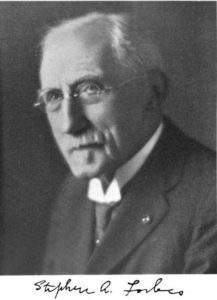
In my generation of fisheries biologists, we were all required to read the 1887 paper, The Lake as a Microcosm. The paper was an early expression of ecological principles—the relationship of organisms to their habitat, the cascading of the food chain, the role of birth rates and death rates in maintaining populations. The author was Stephen A. Forbes, the father of aquatic ecology.
Stephen Alfred Forbes was born on May 29, 1844, in Silver Creek, a small town in far northwestern Illinois. He was the son of a farmer, who died when Forbes was just ten years old. The family was supported thereafter by Forbes’ older brother, who eventually sold the farm to keep the family out of poverty.
When he was 16, Forbes joined the northern army to fight in the Civil War. Though hardly more than a boy, he rose rapidly to the rank of captain. He was captured by the confederacy and held as a prisoner of war for six months. When he was discharged at the end of the war, he attended medical school, but never completed his degree (put off, it is said, by the need to perform surgery without anesthetics). Instead, he taught school and devoted himself to the study of nature, always his fundamental interest.
In 1872, he took a job as curator of the Illinois Natural History Museum in Bloomington, Illinois. When the museum was transferred to the state government five years later, he became its director. During this time, Forbes wrote actively for scientific journals about the natural history of his home state, including some of the earliest descriptions of aquatic invertebrates and an ongoing survey of the biology of the Illinois River. In all, Forbes published more than 500 articles about natural history.
When the museum was renamed the Illinois Natural History Survey and moved to Champaign-Urbana, Forbes moved with it. He was also named the state entomologist and became a professor at the University of Illinois—all without any degrees. That deficiency was corrected in 1884, when the University of Indiana awarded him a doctorate in zoology. Forbes eventually rose to Director of the Illinois Natural History Survey, from 1917 until his death in 1930.
Read More
